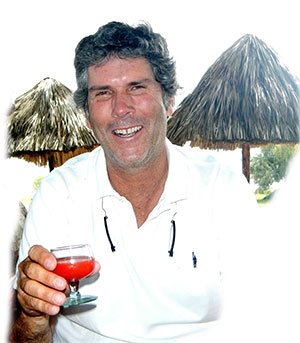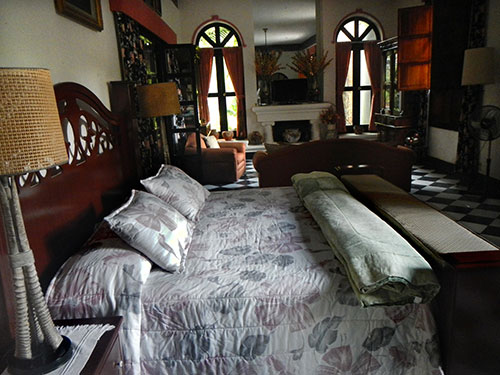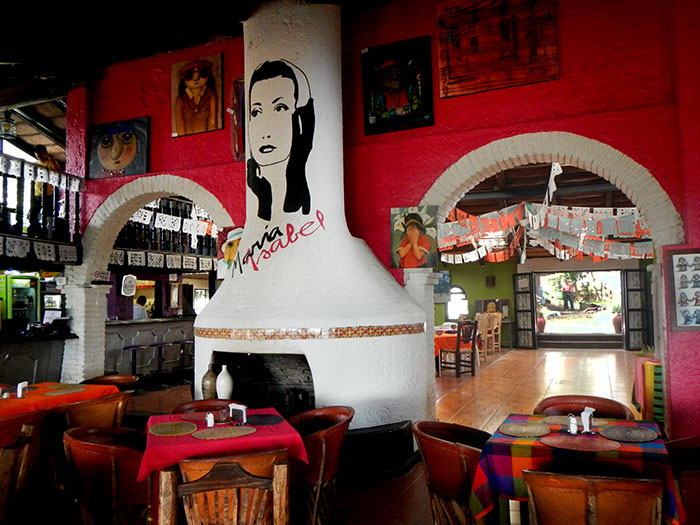|
By John Pint
 Recently I joined Salvador and Diana Mayorga for a tour of
selected historical hot spots in Ajijic and Chapala. Our “Cicerone” for
this visit was Jorge Varela, author of “Mr. Lawrence,” a short piece of historical fiction (in Spanish) based
on D.H. Lawrence's 1923 stay in Chapala, where he began work on his
novel “The Plumed Serpent.”
Recently I joined Salvador and Diana Mayorga for a tour of
selected historical hot spots in Ajijic and Chapala. Our “Cicerone” for
this visit was Jorge Varela, author of “Mr. Lawrence,” a short piece of historical fiction (in Spanish) based
on D.H. Lawrence's 1923 stay in Chapala, where he began work on his
novel “The Plumed Serpent.”
Varela's writing cleverly works in references to La Posada in Ajijic
and to “La Rusa,” the mysterious horsewoman who rode around dressed all
in black while being swindled out of the proceeds of a gold mine just
up the hillside above the town.
First we drove into a residential area called Villa Nova which has
streets with names like Calle de la Mina and Calle de los Mineros.
“Those aren't fanciful names, as in many fraccionamientos,” said Jorge.
“The original Rancho de Oro is still here.” To prove it, he took us to
a stone wall on Calle del Manglar where we hoisted ourselves up just
high enough to get a good peek at the well preserved and beautiful
buildings from which the mining operation was run, with an impressive
arched aqueduct in the background. “Somewhere in the hills just above
us lies the gold mine itself,” said Jorge, “but it's now considered
very dangerous to go inside, with rotting timbers, deep drops and mal
aire. They say several people who entered that mine ended up dead.”
After having stirred up a bit of gold fever in us, Jorge took us
straight to the ruins of the old crushing mill. This is on private
property, but there's no fence, and a family living on the premises
unhesitatingly gave us permission to wander both inside and outside the
decrepit buildings. Outside there's a long, sturdy earthen ramp where
ore-laden wagons were pulled up to the crusher. I would love to revisit
this place with someone knowledgeable about mining!
Next we made a brief visit to the doorway of La Casa de la Rusa at 26
Independencia, where the number plaque shows the silhouette of the
legendary Horsewoman in Black. Her name was Ayenara Zara Alexeyewa, a
Russian ballerina, and according to Judy King's blog she and her dance
partner/foster brother bought the above-mentioned gold mine in the
1920s “hoping to fulfill their dreams to produce and present great
Russian ballets here in Mexico.” Jim and Carole Cook say the mine was
called La Misericordia and La Rusa was being swindled by her Mexican
partners until mine manager Quilocho Retolaza came to her rescue.
Quilocho had been one of Pancho Villa's most dashing officers and La
Rusa herself (under the pen name Frances De Brundige) tells the story
of how he saved her from swindlers and bandits in the book "Quilocho
and the Dancing Stars," available (used) from Amazon.com. There are
lots of old photos and memorabilia about Zara Alexeyewa in La Nueva
Posada's Restaurante La Rusa.
Our last stop in Ajijic was the site of “La Vieja Posada” which was
built in the 1500s and has had many reincarnations. Today it is called
Restaurante María Isabel. Here, says Jorge Varela, is where D. H.
Lawrence (and later many other famous artists) used to stop by for a
Tequila and Sangrita. The correct procedure for imbibing these two
drinks, said our companions, is not to mix them together, but to sip
first one and then the other. Now for this ceremony, the tequila must
be blanco while the sangrita is red. When I asked what was in the
sangrita, I immediately learned what's not in it: alcohol. After that,
I got a different version of the ingredients from each of my friends
and every source I checked. I guess that means you'll always be
surprised when you drink it!
 Finally, we drove to Chapala, to number 307 Zaragoza Street, now known
as Quinta Quetzalcoatl Boutique Hotel B&B. “This is where
Lawrence stayed while he lived in Chapala,” said our Cicerone. The door
was opened by the proprietor, Rob Cracknell, an Australian
painter, who kindly showed us all around. Well, QQ, as they call it in
Chapala, turned out to be one of the most gorgeous places to stay our
friends and I had ever seen, with beautiful trees, fountains, grottos,
flowers and cacti. In the middle of the patio was a charming pool with
a serpent motif, shaped with secluded nooks and a jacuzzi. Lawrence's
room was just as attractive. On the wall was a picture of the writer
and his wife Frieda, along with the text of the telegram Lawrence sent
her in 1923: “Chapala Paradise. Take evening train.” The train is long
gone, but “Chapala Paradise” still says it all.
Finally, we drove to Chapala, to number 307 Zaragoza Street, now known
as Quinta Quetzalcoatl Boutique Hotel B&B. “This is where
Lawrence stayed while he lived in Chapala,” said our Cicerone. The door
was opened by the proprietor, Rob Cracknell, an Australian
painter, who kindly showed us all around. Well, QQ, as they call it in
Chapala, turned out to be one of the most gorgeous places to stay our
friends and I had ever seen, with beautiful trees, fountains, grottos,
flowers and cacti. In the middle of the patio was a charming pool with
a serpent motif, shaped with secluded nooks and a jacuzzi. Lawrence's
room was just as attractive. On the wall was a picture of the writer
and his wife Frieda, along with the text of the telegram Lawrence sent
her in 1923: “Chapala Paradise. Take evening train.” The train is long
gone, but “Chapala Paradise” still says it all.
How to get there:
In Ajijic: The wall where you can hoist yourself up for a peek at the
old mining ranch is in Villa Nova at N20 18.214 W103 16.418 on Calle
del Manglar, about halfway between De los Mineros and Del Arroyo. The
Crushing mill (N20 17.892 W103 16.303) is at the south end of Flores
Magón. La Casa de la Rusa is at 26 Independencia (N20 17.877
W103 15.887), between Aquiles Serdán and 5 de Mayo. La Vieja Posada,
now called Restaurante María Isabel, is located at the south end of
Morelos street at N20 17.828 W103 15.756.
In Chapala: Quinta Quetzalcoatl is number 307 near the south
end of Zaragoza Street, just south of Niños Heroes (N20 17.299 W103
11.467).

“La Vieja Posada” which was
built in the 1500s and has had many reincarnations. Today it is called
Restaurante María Isabel.
|

